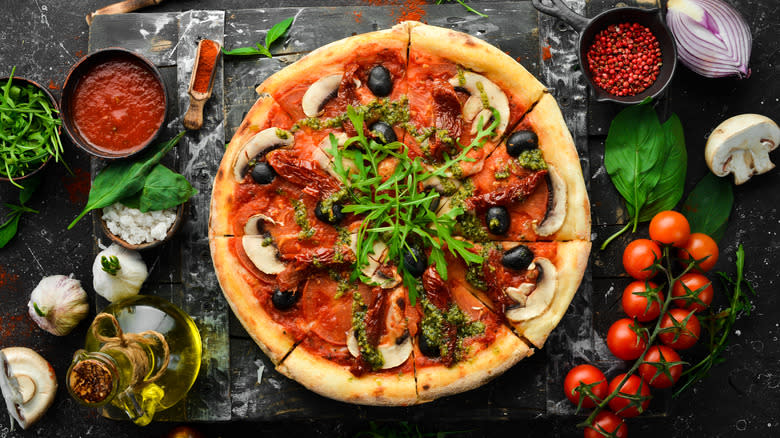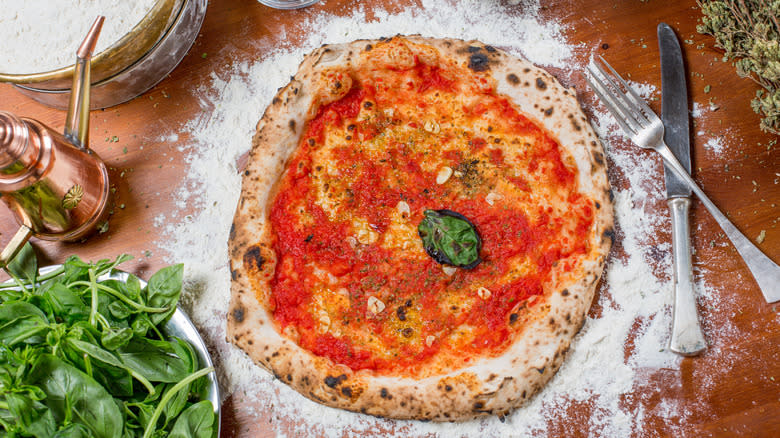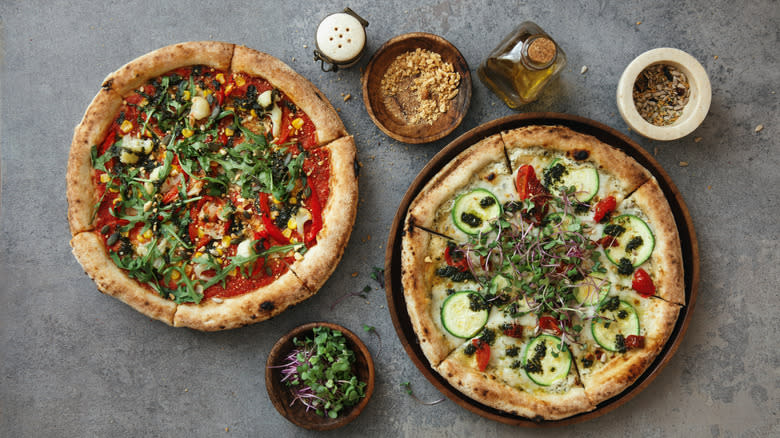If You're Making Vegan Pizza, Say No To Imitation Cheese

We may receive a commission on purchases made from links.
Vegan cheese substitutes are not what they used to be. Ten or 15 years ago, you were lucky to find even one variety of the shredded, vaguely plasticky stuff that never quite melted properly. Now, it's a different story. It's much easier to find vegan cheese at your grocery store these days, including a variety of different brands, styles, and ingredient bases, designed to suit a wide array of dishes.
But non-dairy cheese alternatives do have their drawbacks. Depending on where you shop, you could have trouble finding the kind you're looking for. They're often unsuitable for people with nut or soy allergies. Truth be told, they can run a little pricey, which for you may defeat the purpose of cooking at home to begin with. But hear us out: Pizza, vegan or not, does not need to have cheese. Some traditional kinds of pizza don't include it at all but are balanced and flavorful enough that it doesn't feel like anything is missing. If you cannot swing your preferred vegan cheese or cannot find one you're happy with, just skip it. You can still have a delicious vegan pizza without it.
Read more: The 101 Best Pizzas In America
The First Pizzas Were Cheeseless

Believe it or not, cheese wasn't originally a standard ingredient on pizza. Ancient people had long been making flatbreads with various toppings, but pizza as we know it today was born in the coastal city of Naples in the early part of the 1700s. The very first variety was pizza marinara, topped only with tomato sauce, garlic, and oregano. It actually wasn't until the late 1800s that we have any record of pizza being made with cheese.
Over the past couple of centuries, pizza marinara has become anything but a relic, still highly respected — and legally protected — in Italy. Seriously, there's a regulatory body called the Associazione Verace Pizza Napoletana, which dictates certain standards that a pizza has to meet to be considered true Neapolitan-style pizza. According to the association, there are only three true styles of Neapolitan pizza: marinara, Margherita, and "extra" Margherita. Marinara, by definition, includes only tomato sauce, garlic, and oregano as toppings. If you try to add cheese to a marinara pizza, you run the risk of the pizza police coming after you. (Okay, not really, but the fact that pizza styles are regulated by law should demonstrate how important Italians consider their recipes, even the humble marinara.)
Painting The Town Rosso

All of this is to say, there's nothing wrong with a pizza topped with sauce, seasonings, and nothing else. If anything, a simpler pie really showcases the quality of ingredients and the craftsmanship of the dough. And since your home kitchen isn't governed by the Associazione Verace Pizza Napoletana, you can feel free to add whatever other, vegan-friendly topping you want — capers, mushrooms, fresh basil, what have you.
Of course, your culinary horizons are probably a bit broader than that of the average 18th-century Italian fisherman, so go far beyond the traditional toppings and build a truly original pizza that just happens to not have cheese. You're not even beholden to using red sauce — a homemade cheeseless pesto pie, topped with fresh greens and garden veggies, is a celebration in and of itself. Heck, you could go really out of the box and dress it up with barbecue sauce. Look to some of your favorite bloggers and chefs for inspiration, and then let your pizza fantasies take flight.
Read the original article on Daily Meal.

